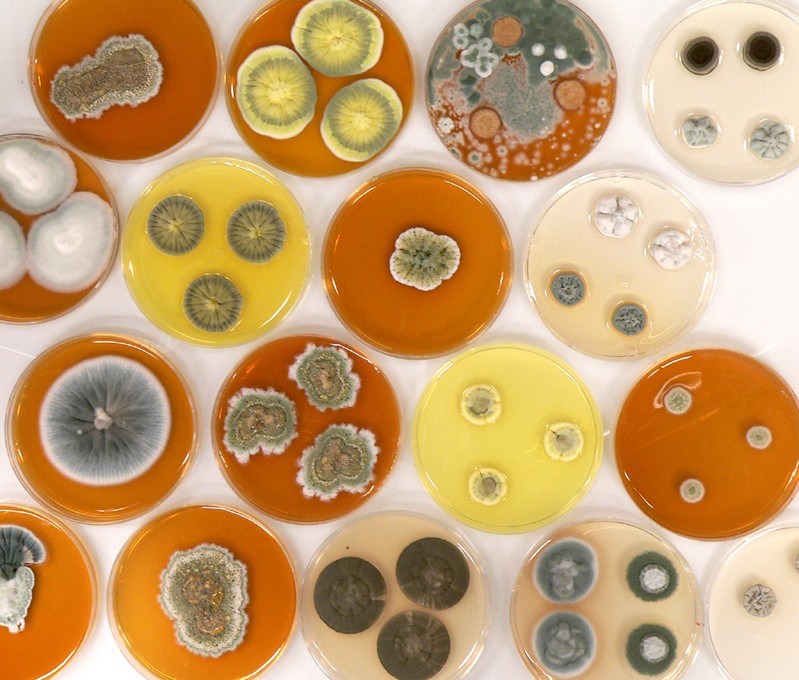Fungi
The study of fungi populations and their dynamics in different environments constitutes a true challenge as an important component of microbial research. As a response to real demands of Portuguese interests, cork fungi isolation and characterisation, was the first approach to something that had expose it self as an exiting and unexplored reality. Therefore, cork fungi are, actually, only one of the research interests of the Group.
Cork taint in wine
The industrial manufacture of cork stoppers has a significant economic impact on the Portuguese economy since Portugal is the largest producer of cork worldwide.
The occurrence of tainting in bottled wine, causing unpleasant alterations in wine flavour or aroma, is responsible for large losses of stock in the wine industry. The most unpleasant of these ‘off-flavours’ is the so-called ‘cork taint’, clearly distinguishable by the musty/mouldy aroma of the wine. Several compounds such as 2,4,6-trichloroanisole (TCA), guaiacol, and 1-octene-3-ol have been associated in the past with ‘cork-taint’.
PCP and TCP degradation mechanisms – TCA formation
The manufacturing process of cork stoppers includes a maturing stage after boiling the cork slabs. During this period, the slabs are completely covered with moulds, which find in cork an environment of temperature, water activity and substrate availability favorable for their development. Those moulds can methylate polychlorinated phenols (PCPs), as a detoxification process, and lead to the appearance of polychloroanisoles (PCAs), which are associated with cork taint defect in bottled wines, and are responsible for loses in the cork industry.
PCP´s were frequently used as biocide, fungicides, mainly as wood preservatives being a common soil and water pollutant.
Several species have been screened for their ability to grow in presence of the PCP´s and/or to metabolise these compounds. Growth inibition was assessed in the presence of different concentrations of PCPs, mainly 2,4,6-trichlorophenol (TCP) and pentachlorophenol (PCP), in solid and liquid cultures. Moreover, the production of some enzymes (peroxidases and laccases) is being studied using molecular and biochemical approaches.
Collaboration with the ITQB - Analytical Chemistry Group
Fungi population dynamics in cork
Natural cork stoppers are an excellent closure material for sealing wine bottles as they enables the proper aging of the wine. Cork is a natural product, therefore recyclable and biodegradable, being inimitable by any synthetic material.
Fungi colonize oak tree forest and are present in the cork namely in its pores (lenticels). The study of the natural mycobiota community present in the cork slabs is very important, not only from an academic point of view, but it may also provide an indication of the future quality of the cork stoppers, which can be dependent on the ability of the colonizing moulds to produce trichloroanisol (TCA), considered responsible by the so called ‘cork taint’ in wine..
To study the biodiversity of the fungi that colonizes the cork slabs, a systematic sampling of cork slab batches was performed along the manufacturing process.
To study the dynamics of those natural fungal communities it is necessary to apply a multi-disciplinary approach. Analysis of the composition of the fungal community started with a careful and systematic sampling plan that was prepared and followed. A direct isolation dilution plating method was used to study the cultivable species, using powered cork as substrate in the culture media. Moreover total population DNA was extracted from powered cork to assess the total population, cultivable and non-cultivable. The ITS region (ITS1-5.8S-ITS2) or b-tubulin gene were amplified by PCR and the DNA mixtures were resolved by denaturing gradient gel electrophoresis (DGGE). The diversity of the total community along the processes was obtained and the composition of the population was assessed by comparison between DGGE lanes of pure and mixed fungal cultures.
All the fungi identification is done in cooperation with Prof R. Samson (CBS-The Netherlands).
Currently we have more than 200 isolates of Penicillium and 15 Aspergillus identified at genus level, from which near 100 Penicillium and 6 Aspergillus are identified at species level. Moreover, Chysonilia sitophila, Trichoderma longibrachiatum and Mucor plumbeus were identified as colonizing cork slabs and also integrate the biological wealthiness of ITQB.

With the purpose of investigating the possible production of volatile compounds, micotoxynes and other extrolites, by some of the most frequent species isolated from the cork in different manufacturing stages, using Gas Chromatography with Mass Spectometry (GC-MS), a strict collaboration was established with Prof J Frisvad (Tech University of Denmark) and with the ITQB - Analytical Chemistry Group.
Also the ability of using fungi as bioremediation agents is on-going trough the collaboration of the Applied and Environmental Mycology group.
...and in water
This is the most recent and interesting chalenge of the Group,which is dealed in collaboration with the Microbiology of man-made environments Group and UNL-FCT, under the scope of the priorities of those entities.



